Regional Airline Business Plan
Puddle Jumpers Airlines, Inc. is a new consumer airline in its formative stages, organized to take advantage of a specific gap in the short-haul domestic travel market. The gap in low-cost service out of Anytown, U.S.A., along with the demand for passenger travel on selected routes, indicates that a new entrant airline could capture a significant portion of air travel business at that hub.
The management of Puddle Jumpers has prior experience in airline start-ups, growing Private Jet Airlines from a single Boeing 727 to a fleet of 16 MD80 series aircraft with revenues of $130 million in a two-year period four years ago.
Research and projections indicate that air travel to and from Anytown is sufficient to provide a new carrier with excellent revenues in its first full year of operations, utilizing six aircraft and selected short-haul routes. Sales figures are based on load factors of only 55% in year one, expected to more than double in year two with additional aircraft and expanded routes. The frequency of flights needed to serve Puddle Jumpers’s target market exceeds the demand that dictated Private Jet’s growth.
These sales levels will produce respectable net profit in the first operational year and exponential growth in year two. Profits in year one will be a modest percent of sales and will improve steadily in year two. The long-term profit target will be 16% of sales in years four and five. The company’s long-term plan is part of the due diligence package. The first operational year is actually fiscal year two in this plan.
The formative operations in the first year will burn cash until revenue can commence due to organizational and regulatory obligations. Investment activity is needed to handle the expenses of this phase of the business.
The chart below illustrates the overall highlights of our business plan for the first three years. Gross Margin is high, as it only includes travel agent commissions, credit card discounts, and federal excise taxes. Travel agent commissions are calculated at 30% of sales, although management expects the actual number to be no more than 10% of sales.
NOTE: For display purposes in this sample plan, numerical values in tables and charts are shown in thousands (000’s).
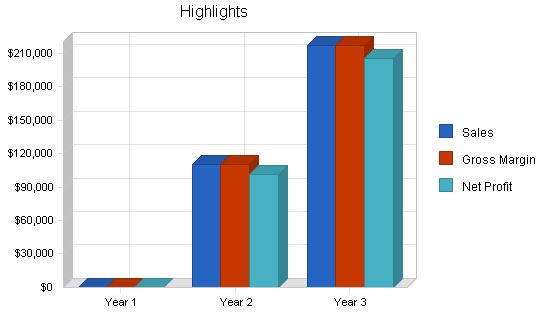
Puddle Jumpers International Airlines, Inc. aims to achieve the following objectives:
1. Obtain required D.O.T. and F.A.A. certifications by month eight.
2. Commence revenue service by the end of year one.
3. Raise sufficient “seed” and “bridge” capital to financially enable these objectives.
4. Commence operations with two McDonnell-Douglas MD-80 series aircraft in month one, four by the end of month four, and six by the end of month six.
5. Add one aircraft per month during year two, reaching a total of 18 by the end of year two.
The mission of Puddle Jumpers is to provide safe, efficient, low-cost air travel service, prioritizing safety above all else. The airline will operate the newest and best-maintained aircraft without compromising on maintenance. Flights will be operated on time, and the service will be friendly and courteous, with no frills.
The keys to success for Puddle Jumpers International Airlines are:
1. Obtaining the required governmental approvals.
2. Securing financing.
3. Having an experienced management team already in place.
4. Addressing channel problems and barriers to entry in marketing, or solving problems with major advertising and promotion budgets.
5. Ensuring product quality and prioritizing safety.
6. Delivering services on time, controlling costs and managing marketing budgets.
7. Controlling costs, with an overall cost per ASM (available seat mile) of 7.0 cents or less in 1996 dollars. Puddle Jumpers aims to be among the lowest-cost airlines in the short-haul market.
Puddle Jumpers International Airlines is a South State Corporation founded by Kenneth D. Smith in July 1996. The airline’s offices are located in Anytown. The management team’s backgrounds are enclosed in the plan.
The company will authorize 20,000,000 shares of common stock, with 1,000,000 shares set aside as founder’s stock for key management personnel. Management stock options will also be available after operations commence, with the total founder’s stock and option stock not exceeding 15% of authorized shares.
Initial "seed" capital will be attracted through a convertible debenture sold by Private Placement, with premium conversion privileges compared to later rounds and "bridge" capital. The company plans to proceed to a public offering before initiating revenue service. The expected proceeds from the Private Placement are $300,000 at the "seed" stage, $3.5 million in "bridge" funding, and $10 million in IPO proceeds (projected at $6 per share). Management cannot guarantee the availability or price of an IPO at the desired time.
In the second year of operations, Puddle Jumpers will expand revenue by adding flights to highly demanded routes. This will make the airline’s schedule more convenient for those destinations, enhancing its competitive advantage. The first level of route expansion includes Chicago, New York, and Anytown, followed by expansion to Philadelphia, Dallas, Washington DC, Orlando, and Detroit.
(Note: Numerical values in tables and charts are shown in thousands for display purposes.)
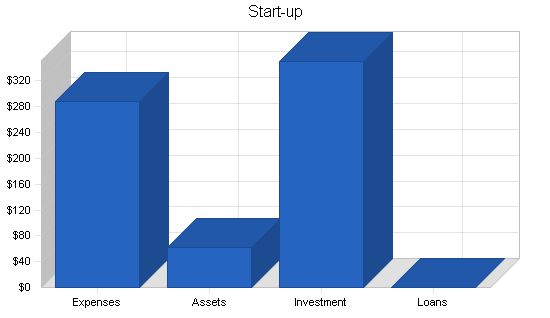
Start-up Requirements:
– Legal: $40
– Stationery, etc.: $3
– Business Plans: $3
– Placement Memorandums: $3
– Investment Banking Retainer: $25
– Underwriting Consultant: $30
– Offering Publicity: $60
– Rent: $6
– Government Compliance: $20
– CEO Salary (6 mos.): $48
– Company Indentity & Marketing: $40
– Expensed Equipment: $10
– Other: $0
– Total Start-up Expenses: $288
Start-up Assets:
– Cash Required: $40
– Other Current Assets: $0
– Long-term Assets: $22
– Total Assets: $62
Total Requirements: $350
Start-up Funding:
– Start-up Expenses to Fund: $288
– Start-up Assets to Fund: $62
– Total Funding Required: $350
Assets:
– Non-cash Assets from Start-up: $22
– Cash Requirements from Start-up: $40
– Additional Cash Raised: $0
– Cash Balance on Starting Date: $40
– Total Assets: $62
Liabilities and Capital:
– Liabilities:
– Current Borrowing: $0
– Long-term Liabilities: $0
– Accounts Payable (Outstanding Bills): $0
– Other Current Liabilities (interest-free): $0
– Total Liabilities: $0
– Capital:
– Planned Investment:
– Owner: $0
– Investor: $0
– Additional Investment Requirement: $350
– Total Planned Investment: $350
– Loss at Start-up (Start-up Expenses): ($288)
– Total Capital: $62
Total Capital and Liabilities: $62
Total Funding: $350
Company Locations and Facilities:
Management plans to lease a small office in suburban Anytown immediately upon closing "seed" funding.
Services:
The following sections describe the service description, competitive comparison, technology, fulfillment, and future services.
Service Description:
Puddle Jumpers provides low-cost air travel to selected destinations from the Anytown, U.S.A. hub. The approach is "no frills" with emphasis on safe, courteous handling of domestic regional passenger travel. All consumer surveys indicate that air travel customers prefer low fares while not compromising on safety or on-time performance. Puddle Jumpers meets the level of service today’s air travel passenger demands.
Competitive Comparison:
The primary competition in the Anytown market is US Air, accounting for 86% of air travel volume. Puddle Jumpers aims to obtain a significant portion of this business with lower costs and a focus on short-haul routes. The operation of a single type of aircraft reduces expenses. Puddle Jumpers will achieve its target of 7 cents or less per available seat mile through cost-saving measures and high flight crew utilization. Eliminating meal service in-flight saves approximately $3.00 per seat per flight. The fleet will be configured to a single coach seating capacity of 165 seats. Puddle Jumpers will utilize a state-of-the-art reservations system for efficiency.
Sales Literature:
All company literature is yet to be developed, including basic corporate identity material and advertising executions.
Fulfillment:
Aircraft will be obtained on a "dry lease" basis from aircraft lessors. Regular maintenance will be performed by Puddle Jumpers personnel, while major maintenance will be outsourced. Airplane parking services, baggage loading and unloading, and baggage and freight handling services will be outsourced. All condiments and beverages served on Puddle Jumpers flights will be purchased from in-flight food service providers.
Technology:
The choice of MD-80 series aircraft offers reliability, availability of parts, and compliance with noise emission standards. Puddle Jumpers will utilize a reservations system that operates faster and requires less training compared to other systems. The reservations system seamlessly integrates with other management information systems. Puddle Jumpers believes that starting an airline today provides advantages in terms of technology.
Future Services:
Puddle Jumpers will offer a one-class seating capacity of 165. Travel will be ticketless, reservations will be handled predominantly using the company’s reservation system, and in-flight service will be on a pay-on-demand basis. Seating will be open with no reserved seats, and no frequent flyer or travel incentives will be offered.
Market Analysis Summary:
Anytown, U.S.A. is an ideal location to start an airline based on extensive research. The airline industry is dominated by major carriers, but there is a potential market segment for a short-haul, single hub, discount fare airline. Puddle Jumpers targets this market segment and believes it is ready for the first entrant with a well-conceived plan, industry experience, and sufficient capitalization.
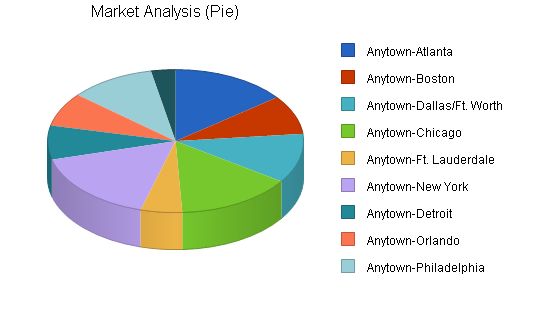
Market Analysis
The Federal Government de-regulated the airline industry in 1978. Prior to that time, the government guaranteed the profitability of the airline industry at the expense of the consumer. Routes were restricted, fares were fixed, and costs got out of control. Today, major carriers continue to operate inefficiently. This has led to the success of discount carriers like Southwest, ValuJet, and U2 by UAL.
Discount carriers have proven their ability to operate profitably and attract customers who previously traveled by other means or not at all.
In 1994, ValuJet Airlines experienced considerable success and rapid growth in Anytown. It forced TWA to abandon its mini-hub in Anytown and grew to over 40 aircraft in two years. Anytown was previously the most expensive city to fly to or from, due to Delta’s dominance.
While ValuJet is an economic success model for start-up airlines, Puddle Jumpers management believes that it should not be the operational model. ValuJet’s current problems are the result of uncontrolled growth.
Many major airlines are experiencing significant losses. Puddle Jumpers management believes these losses can be attributed to high labor costs, operational inefficiency, and poor management. They believe that major carriers cannot compete against start-up carriers with specific market focus and lower cost structures.
In retrospect, de-regulation has provided better service but not necessarily lower prices. Airlines have complained about an under-supply of air travelers, when in fact there is an under-supply of affordable seats. Puddle Jumpers aims to provide affordable seats while maintaining profitability.
Distributing a Service
In the past, airline tickets were primarily sold through the airline or travel agents. However, modern technology has changed the distribution mix. Puddle Jumpers will sell tickets directly through their own reservation agents and an online platform. They expect to sell 90% of tickets directly and offer a ticketless travel option.
Puddle Jumpers expects little to no impact on passenger connections to other airlines, as customers will choose Puddle Jumpers for cost savings. Puddle Jumpers flights will be listed in all available flight information systems.
Competition and Buying Patterns
The critical factor for Puddle Jumpers is building brand awareness and name recognition. Customers prefer to fly with carriers they know and trust. Puddle Jumpers plans to advertise and promote heavily, focusing on safety and on-time performance.
Puddle Jumpers expects to attract both business and leisure travelers in the Anytown market. They don’t believe frequent flyer miles are necessary to compete, as casual travelers don’t fly often enough for them to be significant. Puddle Jumpers will also target major corporations in the Anytown market for business travel.
Main Competitors
The main competitor in the Anytown market is US Air, which has 86% market share. US Air’s high operating costs make them vulnerable. However, Puddle Jumpers does not identify a strategic suitor among the major carriers.
Puddle Jumpers believes the Anytown market is free from imposing competition, unless it comes from another start-up. They aim to gain a first-mover advantage and build critical mass within two years.
Business Participants
The major airlines in the US are not considered direct competition for Puddle Jumpers. The company looks to Southwest as a model for operating a successful discount carrier, ValuJet as a financial model for a start-up, and US Air as an example of mismanaged labor costs.
Puddle Jumpers has learned from their experiences and developed a plan tailored for today’s marketplace.
Strategy and Implementation Summary
Puddle Jumpers will rely on the strategy of serving a specialized niche market well to establish its market presence. They will utilize local and cost-effective media executions, centralize air operations and reservations, and target the leisure and corporate markets through marketing efforts.
The marketing efforts will focus on the local Anytown market. Outdoor billboards, local TV and radio will be the primary media channels used for advertising. The company will also have its own website for customers to make reservations and purchase tickets.
Distribution Strategy
In addition to other marketing programs, Puddle Jumpers will market through their own website, providing customers with the ability to book flights and make payments online.
Pricing Strategy
Due to its low operating costs, Puddle Jumpers will offer fares at less than 50% of the competitive airfares to selected destinations. The fares will vary based on advance purchase and walk-on bookings.
Promotion Strategy
Promotion will primarily be done through outdoor advertising, radio, and TV targeting the Anytown business and leisure traveler. The company will also hire a public relations firm for consumer and financial purposes. The budget allocated for advertising, PR, and reservations is expected to be less than 15% of sales.
Sales Strategy
Puddle Jumpers will make direct sales contacts with Anytown-based corporations and businesses to attract business travelers. They believe their cost structure will be attractive to these businesses, and they anticipate business travel to account for at least 50% of their revenue.
The company forecasts strong sales in the first year of flight operations, with sales more than doubling in the second year. They anticipate attracting a mix of leisure and business travelers in the Anytown market. The projections are based on the analysis provided in the Market Analysis section.
The company has also prepared five-year projections based on expanded service to additional markets. Direct sales costs are not included in the projections but rather reflected as a revenue discount in the projected profit and loss statement. These costs include travel agent commissions, credit card discounts, and federal excise taxes.
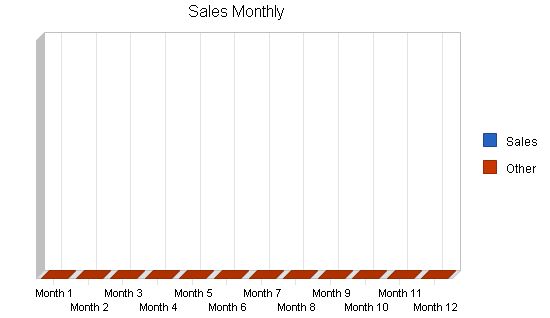
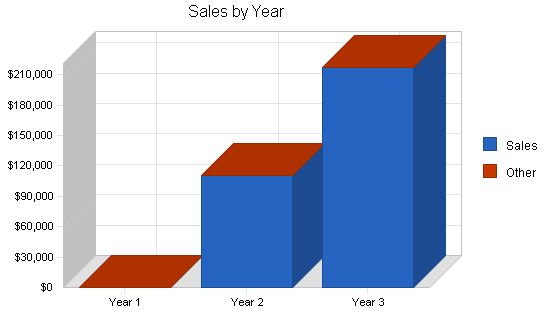
Sales Forecast
| Sales Forecast | |||
| Year 1 | Year 2 | Year 3 | |
| Sales | |||
| Sales | $0 | $110,000 | $216,925 |
| Other | $0 | $0 | $0 |
| Total Sales | $0 | $110,000 | $216,925 |
| Direct Cost of Sales | Year 1 | Year 2 | Year 3 |
| Sales | $0 | $0 | $0 |
| Other | $0 | $0 | $0 |
| Subtotal Direct Cost of Sales | $0 | $0 | $0 |
5.3 Milestones
The table below lists important program milestones, including dates, managers in charge, and budgets for each. The milestone schedule demonstrates our focus on implementation planning.
Management expects that the current regulatory climate will soon become more relaxed. We believe this will be a lasting advantage for well-operated airlines. We consider 1996 to be the ideal time to invest in and launch an airline.
The costs of acquiring additional airplanes are calculated based on the first and last payments made in advance, plus one month’s lease payment.
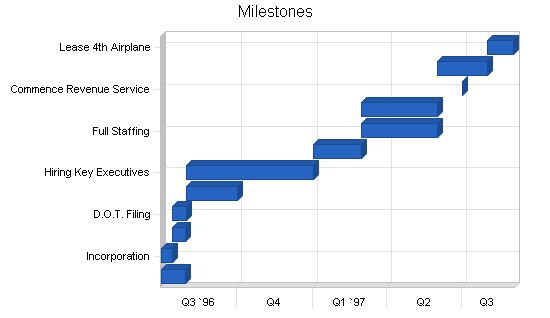
Milestones:
Milestone Start Date End Date Budget Manager Department
Seed Financing 7/1/1996 7/30/1996 $2,500 KDS Executive
Incorporation 7/1/1996 7/15/1996 $2,500 KDS Executive
Private Placement 7/15/1996 7/30/1996 $90,000 KDS Executive
D.O.T. Filing 7/15/1996 8/1/1996 $10,000 KDS Executive
F.A.A. Filing 8/1/1996 10/1/1996 $10,000 KDS Executive
Hiring Key Executives 8/1/1996 1/1/1997 $0 KDS Executive
I.P.O. 1/1/1997 3/1/1997 $0 KDS Executive
Full Staffing 3/1/1997 6/1/1997 $0 KDS Human Res
Lease 2 Airplanes 3/1/1997 6/1/1997 $960,000 KDS Executive
Commence Revenue Service 7/1/1997 7/1/1997 $200,000 KDS Sales
Lease 3rd Airplane 6/1/1997 8/1/1997 $480,000 KDS Executive
Lease 4th Airplane 8/1/1997 9/1/1997 $480,000 KDS Executive
Totals $2,235,000
Management Summary
The management of Puddle Jumpers is highly experienced. Every member of the management team has extensive experience in their respective roles for other airlines. We are not in the business of training key people. We will hit the ground running with a qualified and experienced team. Some of these individuals are currently employed by other airlines and have expressed interest in working for Puddle Jumpers.
Ken Smith is well respected both regionally and federally by the F.A.A. and the D.O.T. The management team is familiar with all necessary approval procedures, having gone through them in the past. The resumes of the key people will enhance our ability to obtain required approvals. A strong management team is necessary to obtain government charters from the D.O.T. and F.A.A.
6.1 Organizational Structure
The company will be organized into five major operational areas: Flight Operations, Maintenance, Financial, Marketing, and Customer Service. Specific positions and job descriptions adhere to government mandates.
6.2 Management Team
Below are the bios and ages of key members of Puddle Jumpers’s management team:
KENNETH D. SMITH, President & CEO, 51
Ken Smith has 28 years of aviation experience, including his time in the U.S. Air Force where he achieved the rank of Captain. He was decorated with the Distinguished Flying Cross, two Commendation Medals, and six Air Medals for his service in the Vietnam War. Ken left the Air Force in 1976 as the Director of Flight Training Programs at the U.S. Air Force Academy. He has held positions as Chief Flight Instructor for Flight International Training School and as a pilot for Braniff Airlines. Ken also served as Executive Vice President and General Manager for Aerostar Airlines, leading a successful turn-around that resulted in Aerostar being acquired by Flight International. He became General Manager of Connie Jones Services, growing the air cargo airline from five to twenty aircraft. Ken then joined Aero Corporation as Vice President of Marketing for their worldwide aircraft maintenance services. In 1991, he became President and CEO of Private Jet, expanding the fleet from one to fifteen aircraft and generating over $130 million in revenue. Ken also played a role in the start-up of Eagle Airlines and served as a consultant for Nations Air.
JAMES B. JONES, Executive Vice President, 49
Mr. Jones has thirty years of flying experience, including distinguished military service. He has held positions as chief pilot, Director of Operations, and General Manager of Air Nevada Airlines, a commuter carrier. He has also served as Director of Operations and Director of Training for Eagle Airlines.
GREER CLARK, Vice President, Operations, 56
Mr. Clark retired from Delta Airlines and currently works as Manager, Flight Test for ValuJet. He has held positions as Chief Pilot for America International Airlines and Vice President of Operations for Private Jet and Eagle Airlines.
DON ADAMS, Vice President, Maintenance, 47
Mr. Adams, an Aeronautical Engineer, has served as Vice President of Ansett Airlines and Vice President of Technical Services for Intercredit Corporation. He is currently Vice President of Avitas and is involved with the National Transportation Safety Board.
BRUCE WING, Vice President, Finance, 50
Mr. Wing is a CPA who has worked as a Vice President for First Chicago Bank and CFO for United Express and Private Jet.
PAUL BERRY, Director of Operations, 57
Mr. Berry is a retired Air Force Colonel and served as General Swartzkoph’s Tanker Task Force Commander for Desert Storm. He is currently Director of Operations at America International Airlines.
TERRY MCADAMS, Chief Pilot, 57
Mr. McAdams served as a pilot with Eastern Airlines for over 25 years. He has also been Chief Pilot for Private Jet and ValuJet, and is qualified on several different aircraft.
SALVATORE DANGELO, Director of Maintenance, 41
Mr. Diangelo has experience in aircraft maintenance at People’s Express Airlines, Continental Airlines, and ValuJet.
CALVIN COBLE, Director of Quality Assurance, 42
Mr. Coble has extensive training and experience as a Class III Inspector for the FAA. He has served as Director of Quality Assurance at Shannon Aerospace.
JIM BEND, Director of Marketing, 49
Mr. Bend has over fifteen years of experience as Regional Sales Manager for Eastern Airlines. He has also served as Director of Sales at Private Jet.
JUDY LAND, Director of Reservations, 38
Ms. Land has over 10 years of experience as Reservations Manager at Eastern Airlines. She has also been involved in designing and implementing reservations systems at Private Jet and World Technologies.
MARY ANN BENNETT, Director of In-flight Services, 43
Ms. Bennett served as a flight attendant at Eastern Airlines before opening her own travel agency. She joined Private Jet as a supervisor of flight attendants and was later promoted to Director.
6.3 Personnel Plan
The table below illustrates personnel needs and growth plans for key executives and category needs by group. All key executives will participate in the company’s stock option plan.
NOTE: For display purposes in this sample plan, numerical values in tables and charts are shown in thousands (000’s).
Personnel Plan
Year 1 Year 2 Year 3
Chief Executive Officer $96 $96 $108
Executive Vice President $42 $84 $96
V.P. Operations $36 $72 $84
V.P. Maintenance $36 $72 $78
V.P. Finance $30 $60 $66
Director of Operations $20 $60 $66
Director of Maintenance $20 $60 $66
Chief Pilot $18 $72 $78
Director of Sales/Marketing $10 $60 $66
Director of Quality Assurance $8 $48 $56
Director of Reservations $8 $48 $54
Director of In-flight Services $8 $48 $52
Flight Crews $0 $4,221 $5,614
Reservations $0 $860 $1,144
Maintenance $0 $950 $1,264
Operations/Training/G&A $0 $1,035 $1,376
Sales/Marketing $0 $180 $240
Finance/Accounting $0 $360 $480
Other $0 $125 $150
Total People 0 0 0
Total Payroll $332 $8,511 $11,138
Adequate financing is essential for a start-up airline. Our strategy is to start with seed financing and then progress to bridge financing before an IPO. This has been a successful model for airline start-ups. Once we have four to six airplanes in operation, we can continue to operate profitably even if additional capital becomes unavailable on attractive terms.
7.1 Important Assumptions
The financial plan is based on important assumptions, including a slow-growth economy, no major technological changes, and access to equity capital and financing as needed.
General Assumptions
Year 1 Year 2 Year 3
Plan Month 1 2 3
Current Interest Rate 10.00% 10.00% 10.00%
Long-term Interest Rate 10.00% 10.00% 10.00%
Tax Rate 0.00% 0.00% 0.00%
Other 0 0 0
7.2 Key Financial Indicators
The most important measurements in the airline business are cost per Available Seat Mile and System Utilization Factor. If seat costs are below 7 cents and utilization is above 50%, the airline will operate profitably.
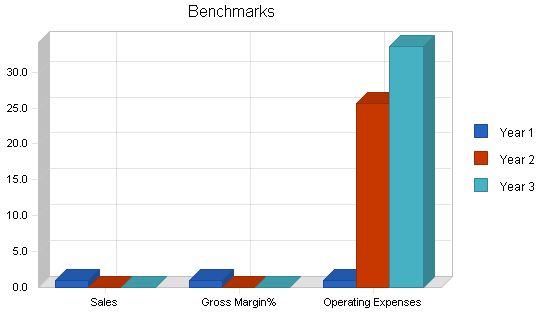
7.3 Break-even Analysis
By excluding operational costs for flying aircraft and considering only fixed overhead and aircraft leases, the company can break even on the first six airplanes with sales just above $2 million per month or approximately $24 million in year one. This represents less than 25% of our sales forecast but demonstrates the company’s ability to sustain itself without adding planes and routes for an indefinite period with load factors below 15%.
NOTE: Numerical values in tables and charts in this sample plan are displayed in thousands (000’s) for clarity.
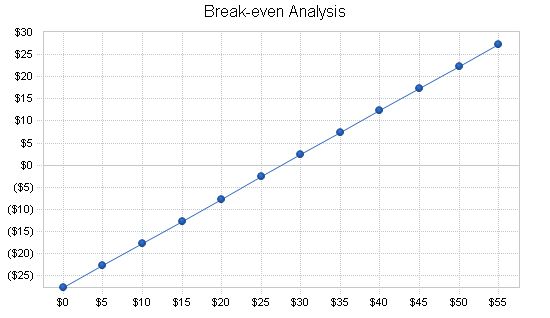
Monthly Revenue Break-even: $28
Assumptions:
Average Percent Variable Cost: 0%
Estimated Monthly Fixed Cost: $28
7.4 Projected Profit and Loss
Our profits improve from a low percent of sales in year one to a modest percent of sales in year two. They are expected to peak at a respectable percentage in year three and beyond. In terms of gross numbers, we generate healthy profit in the second operational year.
NOTE: Numerical values in tables and charts are shown in thousands (000’s) for display purposes in this sample plan.
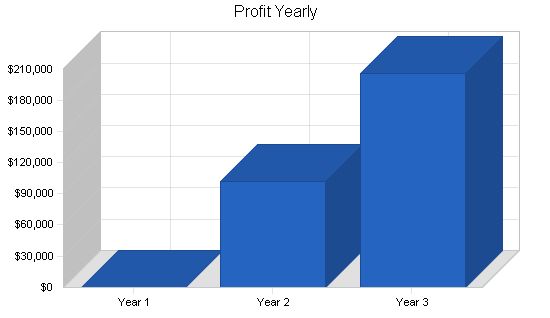
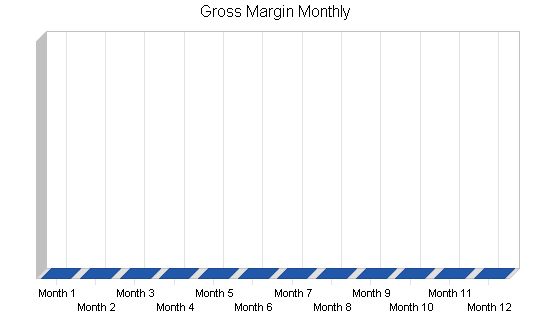
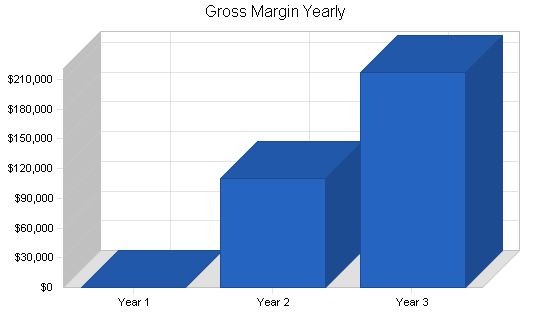
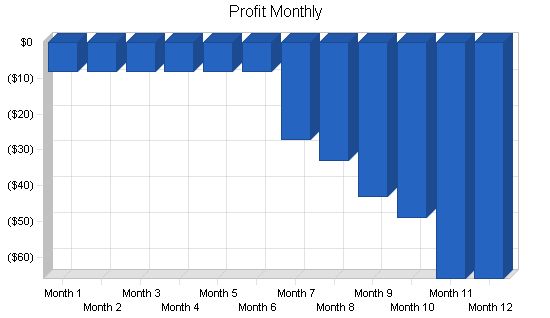
Pro Forma Profit and Loss
| Pro Forma Profit and Loss | |||
| Year 1 | Year 2 | Year 3 | |
| Sales | $0 | $110,000 | $216,925 |
| Direct Cost of Sales | $0 | $0 | $0 |
| Other Costs of Sales | $0 | $0 | $0 |
| Total Cost of Sales | $0 | $0 | $0 |
| Gross Margin | $0 | $110,000 | $216,925 |
| Gross Margin % | 0.00% | 100.00% | 100.00% |
| Expenses | |||
| Payroll | $332 | $8,511 | $11,138 |
| Marketing/Promotion | $0 | $0 | $0 |
| Depreciation | $0 | $0 | $0 |
| Rent | $0 | $0 | $0 |
| Utilities | $0 | $0 | $0 |
| Insurance | $0 | $0 | $0 |
| Payroll Taxes | $0 | $0 | $0 |
| Other | $0 | $0 | $0 |
| Total Operating Expenses | $332 | $8,511 | $11,138 |
| Profit Before Interest and Taxes | ($332) | $101,489 | $205,787 |
| EBITDA | ($332) | $101,489 | $205,787 |
| Interest Expense | $0 | $0 | $0 |
| Taxes Incurred | $0 | $0 | $0 |
| Net Profit | ($332) | $101,489 | $205,787 |
| Net Profit/Sales | 0.00% | 92.26% | 94.87% |
7.5 Projected Cash Flow
This business plan cash flows positively from the initial infusion of investment forward. It will continue to produce cash as long as sales targets are met. Borrowing may only be required if seasonal fluctuations occur or if expansion plans are further accelerated.
The chart below illustrates the accumulation of first-year cash during the formative stage.
NOTE: For display purposes in this sample plan, numerical values in tables and charts are shown in thousands (000’s).
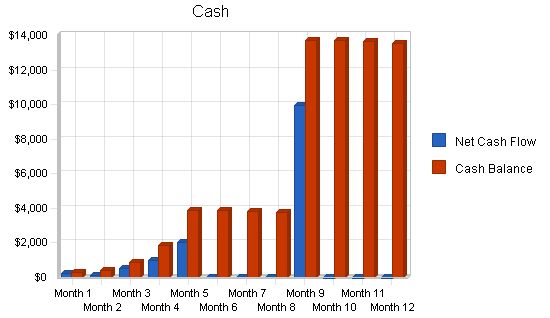
Pro Forma Cash Flow:
Year 1 Year 2 Year 3
Cash Received:
Cash from Operations:
Cash Sales $0 $110,000 $216,925
Subtotal Cash from Operations $0 $110,000 $216,925
Additional Cash Received:
Sales Tax, VAT, HST/GST Received $0 $0 $0
New Current Borrowing $0 $0 $0
New Other Liabilities (interest-free) $0 $0 $0
New Long-term Liabilities $0 $0 $0
Sales of Other Current Assets $0 $0 $0
Sales of Long-term Assets $0 $0 $0
New Investment Received $13,850 $0 $0
Subtotal Cash Received $13,850 $110,000 $216,925
Expenditures:
Expenditures from Operations:
Cash Spending $332 $8,511 $11,138
Bill Payments $0 $0 $0
Subtotal Spent on Operations $332 $8,511 $11,138
Additional Cash Spent:
Sales Tax, VAT, HST/GST Paid Out $0 $0 $0
Principal Repayment of Current Borrowing $0 $0 $0
Other Liabilities Principal Repayment $0 $0 $0
Long-term Liabilities Principal Repayment $0 $0 $0
Purchase Other Current Assets $0 $0 $0
Purchase Long-term Assets $0 $0 $0
Dividends $0 $0 $0
Subtotal Cash Spent $332 $8,511 $11,138
Net Cash Flow $13,518 $101,489 $205,787
Cash Balance $13,558 $115,047 $320,834
Projected Balance Sheet:
The projected balance sheet shows the growth of the business’s net worth and can estimate future stock values based on industry multiples.
NOTE: Numerical values in tables and charts are displayed in thousands (000’s).
Pro Forma Balance Sheet:
Year 1 Year 2 Year 3
Assets:
Current Assets:
Cash $13,558 $115,047 $320,834
Other Current Assets $0 $0 $0
Total Current Assets $13,558 $115,047 $320,834
Long-term Assets:
Long-term Assets $22 $22 $22
Accumulated Depreciation $0 $0 $0
Total Long-term Assets $22 $22 $22
Total Assets $13,580 $115,069 $320,856
Liabilities and Capital:
Current Liabilities:
Accounts Payable $0 $0 $0
Current Borrowing $0 $0 $0
Other Current Liabilities $0 $0 $0
Subtotal Current Liabilities $0 $0 $0
Long-term Liabilities $0 $0 $0
Total Liabilities $0 $0 $0
Paid-in Capital $14,200 $14,200 $14,200
Retained Earnings ($288) ($620) $100,869
Earnings ($332) $101,489 $205,787
Total Capital $13,580 $115,069 $320,856
Total Liabilities and Capital $13,580 $115,069 $320,856
Net Worth $13,580 $115,069 $320,856
The following business measurement ratios are based on projections for Puddle Jumpers. The ratios for each year are shown below. Industry profile ratios for Scheduled Passenger Air Transportation (NAICS code 481111) are included for comparison.
Ratio Analysis:
Year 1 Year 2 Year 3 Industry Profile
Sales Growth 0.00% 0.00% 97.20% 11.52%
Percent of Total Assets:
Other Current Assets 0.00% 0.00% 0.00% 43.73%
Total Current Assets 99.84% 99.98% 99.99% 65.07%
Long-term Assets 0.16% 0.02% 0.01% 34.93%
Total Assets 100.00% 100.00% 100.00% 100.00%
Current Liabilities:
Accounts Payable 0.00% 0.00% 0.00% 32.81%
Long-term Liabilities 0.00% 0.00% 0.00% 25.84%
Total Liabilities 0.00% 0.00% 0.00% 58.65%
Net Worth 100.00% 100.00% 100.00% 41.35%
Percent of Sales:
Sales 100.00% 100.00% 100.00% 100.00%
Gross Margin 0.00% 100.00% 100.00% 55.90%
Selling, General & Administrative Expenses 0.00% 85.78% 76.98% 31.28%
Advertising Expenses 0.00% 62.07% 52.09% 0.66%
Profit Before Interest and Taxes 0.00% 92.26% 94.87% 0.16%
Main Ratios:
Current 0.00 0.00 0.00 1.65
Quick 0.00 0.00 0.00 0.92
Total Debt to Total Assets 0.00% 0.00% 0.00% 65.97%
Pre-tax Return on Net Worth -2.44% 88.20% 64.14% 0.20%
Pre-tax Return on Assets -2.44% 88.20% 64.14% 0.60%
Additional Ratios:
Net Profit Margin 0.00% 92.26% 94.87% n.a.
Return on Equity -2.44% 88.20% 64.14% n.a.
Activity Ratios:
Accounts Payable Turnover 0.00 0.00 0.00 n.a.
Payment Days 0 0 0 n.a.
Total Asset Turnover 0.00 0.96 0.68 n.a.
Debt Ratios:
Debt to Net Worth 0.00 0.00 0.00 n.a.
Current Liab. to Liab. 0.00 0.00 0.00 n.a.
Liquidity Ratios:
Net Working Capital $13,558 $115,047 $320,834 n.a.
Interest Coverage 0.00 0.00 0.00 n.a.
Additional Ratios:
Assets to Sales n.a. 1.05 1.48 n.a.
Current Debt/Total Assets 0% 0% 0% n.a.
Acid Test 0.00 0.00 0.00 n.a.
Sales/Net Worth 0.00 0.96 0.68 n.a.
Dividend Payout 0.00 0.00 0.00 n.a.
Appendix:
Sales Forecast:
Month 1 Month 2 Month 3 Month 4 Month 5 Month 6 Month 7 Month 8 Month 9 Month 10 Month 11 Month 12
Sales
Sales 0% $0 $0 $0 $0 $0 $0 $0 $0 $0 $0 $0 $0 $0
Other 0% $0 $0 $0 $0 $0 $0 $0 $0 $0 $0 $0 $0 $0
Total Sales $0 $0 $0 $0 $0 $0 $0 $0 $0 $0 $0 $0 $0
Direct Cost of Sales:
Month 1 Month 2 Month 3 Month 4 Month 5 Month 6 Month 7 Month 8 Month 9 Month 10 Month 11 Month 12
Sales
Other
Subtotal Direct Cost of Sales $0 $0 $0 $0 $0 $0 $0 $0 $0 $0 $0 $0 $0
Personnel Plan:
Chief Executive Officer: 0%, $8, $8, $8, $8, $8, $8, $8, $8, $8, $8, $8, $8, $8
Executive Vice President: 0%, $0, $0, $0, $0, $0, $0, $7, $7, $7, $7, $7, $7, $7
V.P. Operations: 0%, $0, $0, $0, $0, $0, $0, $6, $6, $6, $6, $6, $6, $6
V.P. Maintenance: 0%, $0, $0, $0, $0, $0, $0, $6, $6, $6, $6, $6, $6, $6
V.P. Finance: 0%, $0, $0, $0, $0, $0, $0, $0, $6, $6, $6, $6, $6, $6
Director of Operations: 0%, $0, $0, $0, $0, $0, $0, $0, $0, $5, $5, $5, $5, $5
Director of Maintenance: 0%, $0, $0, $0, $0, $0, $0, $0, $0, $5, $5, $5, $5, $5
Chief Pilot: 0%, $0, $0, $0, $0, $0, $0, $0, $0, $0, $0, $6, $6, $6
Director of Sales/Marketing: 0%, $0, $0, $0, $0, $0, $0, $0, $0, $0, $0, $5, $5
Director of Quality Assurance: 0%, $0, $0, $0, $0, $0, $0, $0, $0, $0, $0, $4, $4
Pro Forma Cash Flow:
Cash Received
Cash Sales
Subtotal Cash from Operations
Additional Cash Received
Sales Tax, VAT, HST/GST Received
New Current Borrowing
New Other Liabilities (interest-free)
New Long-term Liabilities
Sales of Other Current Assets
Sales of Long-term Assets
New Investment Received
Subtotal Cash Received
Expenditures
Expenditures from Operations
Cash Spending
Bill Payments
Subtotal Spent on Operations
Additional Cash Spent
Sales Tax, VAT, HST/GST Paid Out
Principal Repayment of Current Borrowing
Other Liabilities Principal Repayment
Long-term Liabilities Principal Repayment
Purchase Other Current Assets
Purchase Long-term Assets
Dividends
Subtotal Cash Spent
Net Cash Flow
Cash Balance
Pro Forma Balance Sheet:
Assets
Starting Balances
Current Assets
Cash
Other Current Assets
Total Current Assets
Long-term Assets
Long-term Assets
Accumulated Depreciation
Total Long-term Assets
Total Assets
Liabilities and Capital
Current Liabilities
Accounts Payable
Current Borrowing
Other Current Liabilities
Subtotal Current Liabilities
Long-term Liabilities
Total Liabilities
Paid-in Capital
Retained Earnings
Earnings
Total Capital
Total Liabilities and Capital
Net Worth

Business Plan Outline
- Executive Summary
- Company Summary
- Services
- Market Analysis Summary
- Strategy and Implementation Summary
- Management Summary
- Financial Plan
- Appendix
Hello!
I’m Andrew Brooks, a seasoned finance consultant from the USA and the mind behind phonenumber247.com.
My career is built on a foundation of helping individuals and businesses thrive financially in an ever-changing economic landscape. At phonenumber247.com, my aim is to demystify the complex world of finance, providing clear, actionable advice that can help you navigate your financial journey with confidence. Whether it’s personal finance management, investment strategies, or understanding the nuances of market dynamics, I’m here to share insights and tools that can propel you towards your financial goals.
Welcome to my digital space, where every piece of advice is a step closer to financial clarity and success!
